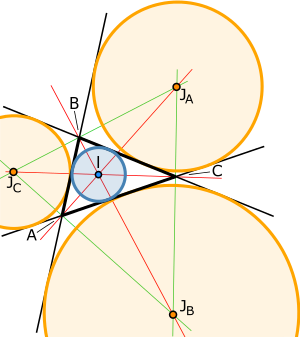
In geometry, the incircle or inscribed circle of a triangle is the largest circle that can be contained in the triangle; it touches (is tangent to) the three sides. The center of the incircle is a triangle center called the triangle's incenter.[1]
An excircle or escribed circle[2] of the triangle is a circle lying outside the triangle, tangent to one of its sides and tangent to the extensions of the other two. Every triangle has three distinct excircles, each tangent to one of the triangle's sides.[3]
The center of the incircle, called the incenter, can be found as the intersection of the three internal angle bisectors.[3][4] The center of an excircle is the intersection of the internal bisector of one angle (at vertex A, for example) and the external bisectors of the other two. The center of this excircle is called the excenter relative to the vertex A, or the excenter of A.[3] Because the internal bisector of an angle is perpendicular to its external bisector, it follows that the center of the incircle together with the three excircle centers form an orthocentric system.[5]
- ^ Kay (1969, p. 140)
- ^ Altshiller-Court (1925, p. 74)
- ^ a b c Altshiller-Court (1925, p. 73)
- ^ Kay (1969, p. 117)
- ^ Johnson 1929, p. 182.